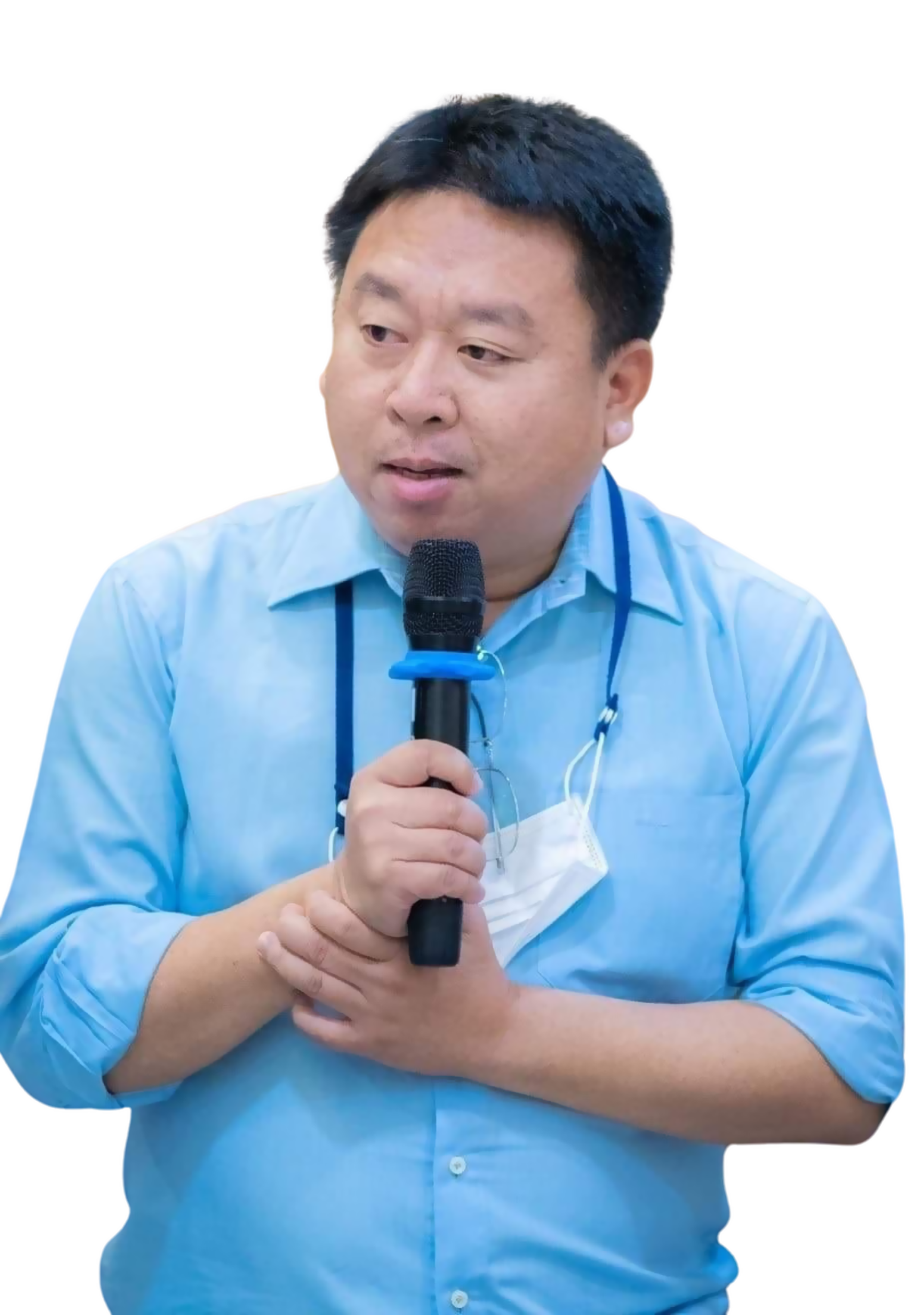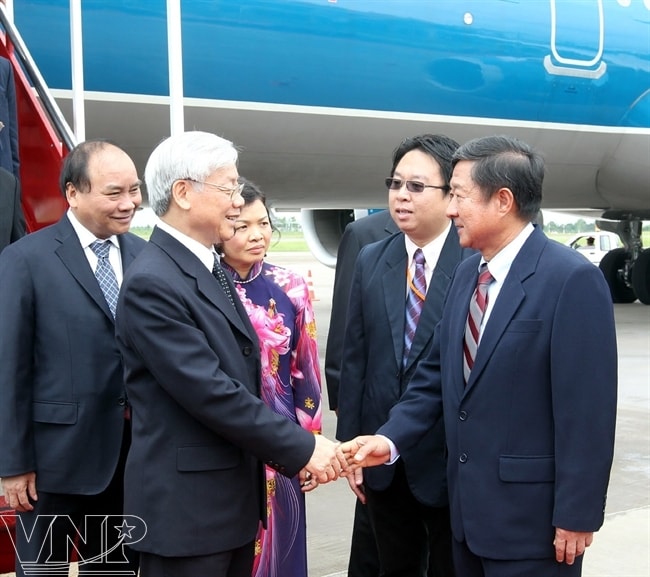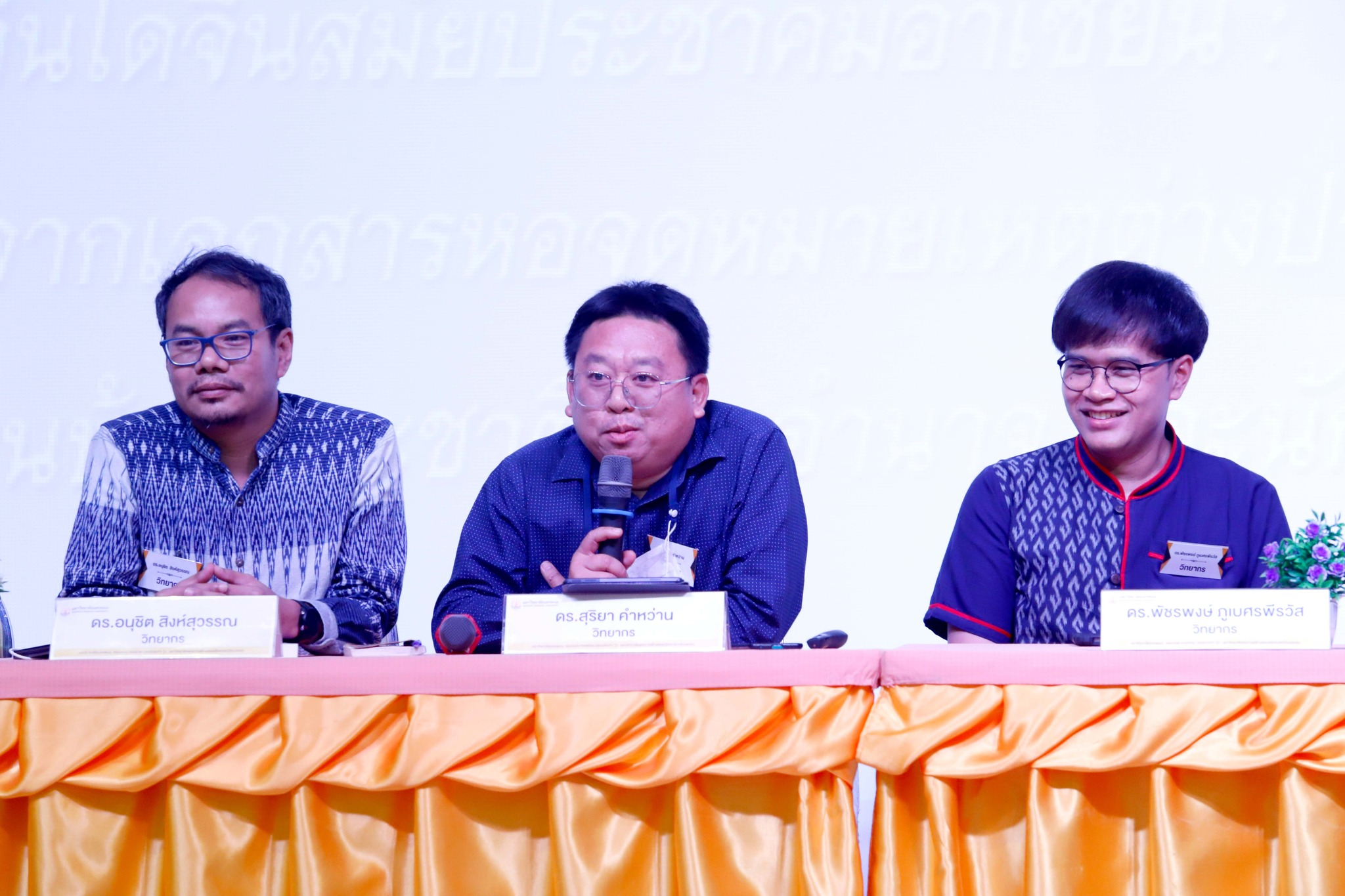Children of Vietnam - Thailand friendship
(Baonghean.vn) - On the last day of the year, we happened to meet Dr. Suriya Khamwan again when he and a delegation from the Northeastern provinces of Thailand visited Nghe An on the occasion of the 20th anniversary of the establishment of the Nghe An Vietnam - Thailand Friendship Association.
On a chilly afternoon in the new urban area of Vinh Tan, a Thai-Vietnamese doctor could not hide his surprise at the development of Vinh city: “Vinh as well as Nghe An has developed so quickly. 20 years ago, when I went to Vinh University to study for a master's degree in Linguistics, this place was still a water spinach field, a black sewage dump. Yet, now it is the city's VIP area. Back then, Vinh did not have many cars, not many high-rise buildings, and did not have a walking street like today....".
Obey Uncle Ho's teachings
Dr. Suriya Khamwan's Vietnamese name is Vu Dinh Phu. The Vietnamese community in Northeast Thailand affectionately calls him "Teacher Phu". His grandparents were from Y Yen (Nam Dinh), and were part of the group of people who crossed Truong Son, through Laos, and went to Northeast Thailand in the period of 1931 - 1935. Among the Vietnamese who migrated to Thailand during that period, there were many people from Nghe An and Ha Tinh who were oppressed by the French colonialists after the Nghe - Tinh Soviet movement. Before this migration, Nghe people were already present in Northeast Thailand, building villages. Prominent among the Vietnamese villages in Northeast Thailand is the Ban May area, where Nguyen Ai Quoc, also known as Thau Chin, and his comrades came to live, enlighten, and propagate the revolution to overseas Vietnamese...
 |
Dr. Suriya Khamwan's Vietnamese name is Vu Dinh Phu. |
Dr. Suriya Khamwan was born in 1974, is the third generation of Vietnamese born in Thailand, holds Thai nationality, married a Thai woman, but he always has a strong attachment to his homeland Vietnam, especially Nghe An. Suriya Khamwan said that people from Nghe An and Ha Tinh were the first to arrive in Nakhon Phanom as well as the northeastern provinces of Thailand. They went to Thailand to avoid persecution by the French colonialists, to avoid being drafted into the army and to make a revolution. They came to Thailand with nothing, but diligence, hard work and community solidarity helped Vietnamese people in general and Nghe An people in particular quickly stabilize their lives, have food, property and resources to help their homeland which was being oppressed and suffering.
People from Nghe An such as Dang Thuc Hua, Dang Quynh Anh, Nguyen Sy Sach, Vo Trong Dai, Ho Tung Mau and especially President Ho Chi Minh are shining examples, respected by the Vietnamese community in Thailand. Initially, when they first came to Thailand, Nghe An people only considered this place as a place of refuge, always wanting to return to participate in the revolutionary movement, waiting for the day of independence. They did not integrate into life in Thailand, did not learn Thai language...
 |
The house where leader Nguyen Ai Quoc, also known as Thau Chin, lived and worked in Nakhon Phanom (Thailand). |
In 1928, when he went to Thailand to build a revolutionary movement in the Vietnamese community, leader Nguyen Ai Quoc, who took the name Thau Chin, advised everyone that the nation's resistance would be long, and that people needed to learn Thai, integrate with the local culture and the local government. Only then would their lives improve and they would have resources to turn to their homeland. They would gain the sympathy of the people and the local government would support the revolutionary movements of overseas Vietnamese....
Following Uncle Ho's teachings, generations of Nghe An people in particular and Vietnamese people in general have always united and gradually integrated into Thai society. They consider Thailand their second homeland and have made many contributions to their homeland in the two resistance wars against foreign invaders as well as in the process of building the country later on...
Also from Uncle Ho's teachings, Suriya Khamwan has his own choices on the path of career development. Although his family has a very large business in Nakhon Phanom, he does not pursue a business career, because he always keeps in mind that he must do "something meaningful" for the Vietnamese community, for Vietnamese culture...
In 1960, when Uncle Ho called on overseas Vietnamese to return to build and defend the Fatherland, the Vietnamese community in Thailand quickly responded. According to Thai figures in 1960, in a short time, 70,042 people registered to return to North Vietnam via Hai Phong Port. From the first trip on January 10, 1960 to early 1964, there were 75 repatriation ships with about 45,536 people...
Rekindle the flame of love for the homeland
After graduating with a bachelor's degree in history, Suriya Khamwan continued to study Vietnamese culture and language. In 2002, he went to Vinh University to study for a master's degree, majoring in Linguistics. In 2004, when Suriya Khamwan graduated with a master's degree, the Thai Government had a policy of increasing foreign language training for students, prioritizing countries with potential in Southeast Asia with the ambition of training a high-quality workforce, ready to dominate the markets of countries in the region when the ASEAN community was formed. Suriya Khamwan was invited to teach at the Faculty of Culture, Nakhon Phanom University. His main task was to teach Vietnamese language and culture to Thai students. During this time, he both taught and completed his doctoral program, becoming a doctorate in Culture.
 |
Dr. Suriya Khamwan gave a scientific report on the topic of Thailand-Vietnam Relations at a conference organized by Nakhon Phanom University in collaboration with the Royal Thai Army Academy. |
With his passionate activities in teaching Vietnamese and promoting Vietnamese culture in Thailand, Dr. Suriya Khamwan's reputation in the community is increasingly affirmed. He was trusted by the Nakhon Phanom provincial government to be an interpreter for Vietnamese delegations visiting and working in the province. In June 2013, when General Secretary Nguyen Phu Trong visited Thailand, he was assigned the task of interpreting.
 |
| Dr. Suriya Khamwan and Nakhon Phanom provincial leaders welcomed General Secretary Nguyen Phu Trong, June 2013. |
He was also the main interpreter for the high-level delegation of Nakhon Phanom province at the Vietnam - Laos - Thailand Summit using Highway 8 and Highway 12, held alternately in Nakhon Phanom, Nghe An, Bolikhamxay (Laos). Suriya Khamwan is also a member of the Thai - Vietnamese Association of Nakhon Phanom province; a member of the Secretariat of the Association of Vietnamese People in Thailand... He also connected visits and work of leaders of Vinh University, Ha Tinh University and universities in Hanoi to work with Nakhon Phanom University; advised the Nakhon Phanom - Hanoi Friendship Center on teaching Vietnamese; brought dozens of Thai students to Vietnam to study Vietnamese and vice versa...
In Nakhon Phanom, there is the Thai-Vietnamese Friendship Village with the most important address being the house of Thau Chin (President Ho Chi Minh), the house of Mr. Vo Trong Dai, from Hung Nguyen district, a friend of Uncle Ho, where the revolutionary predecessors chose as their base in Thailand. Suriya Khamwan said that since 2004, when the Friendship Village was established and the President Ho Chi Minh Memorial House was built, Nakhon Phanom has become a "red address", an indispensable destination for all tourist groups when coming to Northeast Thailand. "In 2022, Nakhon Phanom is ranked in the Top 2 in Thailand in terms of tourism. Not only Vietnamese people come to the Friendship Village, but tourists and researchers from Europe, East Asia, America... also come here to learn more about Uncle Ho's activities in Thailand," he shared.
 |
Exchange about Vietnamese culture at the Thai Army School. |
Enthusiastically talking about the lives of Vietnamese people in Thailand, about the changes in the May village in Nakhon Phanom, about the house where Uncle Ho lived with familiar objects like in the Kim Lien Relic Site (Nam Dan); about the altars with portraits of President Ho Chi Minh and the national flag in every Vietnamese house... Suriya Khamwan's voice suddenly dropped when I asked about how Vietnamese people in Thailand use Vietnamese. He said: "The 3rd, 4th, 5th generation of Vietnamese people in Thailand now rarely use Vietnamese, they use English and Thai. This is also true, because they are Thai people, they have integrated into Thai society for decades. The Thai government recognizes the Vietnamese as an ethnic minority in Thailand. Very few young people now can use Vietnamese."
As a PhD in culture, working in the field of education, Suriya Khamwan determined that people like him must be responsible for lighting the flame of love for the Vietnamese language in the young generation of Vietnamese people in Thailand. With that in mind, he quietly opened Vietnamese classes for Vietnamese people, taught Vietnamese to leaders of Nakhon Phanom University, coordinated with the Vietnamese Embassy and the Association of Vietnamese People in Thailand to organize Vietnamese cultural festivals... "Young Thai people of Vietnamese origin are always proud of their homeland, their ancestors are Vietnamese, descendants of Uncle Ho. It is just because they are absorbed in life and do not have many opportunities to use Vietnamese that their Vietnamese language is lost. Our responsibility is to gradually pass on and sow the love for the Vietnamese language and culture to young people," he confided.
The mission of transmitting and rekindling the flame of love for the Vietnamese language is quietly carried out by Suriya Khamwan in many different ways. Currently, he is making the documentary "Returning Overseas Vietnamese" sponsored by the Cultural Development Fund of the Thai Government. He said: "The film has 7 episodes, 6 episodes will be completed in 2022, the remaining episode will be completed in early 2023. One of the highlights of the film is the scenes filmed in Nghe An and Hanoi, where many people who returned to build the country following the call of Uncle Ho are living, working and quite successful. We are impressed with the Nghe An people who returned from Thailand and are very successful in the wards: Doi Cung, Cua Nam, Le Loi, with the overseas Vietnamese village in Quy Chau, Thai Hoa Town... These people are also the thread connecting the strong relationship between the two communities, contributing to deepening the relationship between Vietnam and Thailand".
 |
The Thai film crew of overseas Vietnamese returning home filmed a scene in Vinh city. |
This time returning to Vietnam, Suriya Khamwan and his colleagues finished filming at Vinh market, Tran Hung Dao street, Vinh Railway Station market, Lang Sen village and several other locations in Hanoi. “Vinh, Nghe An has developed so quickly, so impressively. We are very happy that people from Thailand have returned to their hometowns, everyone is well off, everyone is proud that they have two hometowns, taught by Uncle Ho, returning to their hometowns at Uncle Ho's call, but they always remember the difficult days in Northeast Thailand.
Just like the Vietnamese people in Thailand today, we always look back to our homeland and country with pride and gratitude,” Suriya Khamwan shared and affirmed: “We Thai people of Vietnamese origin grew up when the country was at peace, but the teachings of our predecessors are always the torch that lights the way for us to strive. Nakhon Phanom has Uncle Ho's house, Nghe An is Uncle Ho's hometown. This is a source of pride, a similarity for the two provinces to connect, opening up opportunities for comprehensive cooperation, especially in the fields of investment and tourism. For me, no matter where I am, in any circumstance, I will try to contribute my best for the development of the community, for the identity of the nation, for the Vietnam - Thailand friendship.”
After leaving Nghe An, returning to Vietnam by road through the Ho Chi Minh Trail, crossing the Cha Lo Border Gate (Quang Binh), Dr. Suriya Khamwan wrote on his personal page "The Ho Chi Minh Trail in the war against America. From the path of war and death to the path of trade, the path of happiness", along with a picture of Milestone 528 on the Vietnamese side with Laos. Passing this milestone, following Highway 12, crossing the Friendship Bridge over the Mekong River, you will reach Nakhon Phanom.
This is also the strategic route in the East-West Economic Corridor that the three countries of Vietnam - Laos - Thailand are building. I know that one day in the not too distant future, when the East-West Economic Corridor develops, when the economic community truly becomes the pillar of the ASEAN community, the residents of the three countries will have new opportunities for cooperation, they will join hands, sing the song of solidarity, the song of happiness and prosperity as the goal set by the governments of the three countries...
Nakhon Phanom and Central Vietnam have a close geopolitical relationship. As soon as he arrived in Thailand, leader Nguyen Ai Quoc considered this a strategic location, a point of reception for patriots and revolutionaries from Vietnam. During the resistance war against the US, Nakhon Phanom airbase was also where the US imperialists placed the brain of the MC Namara electronic fence... The revolutionary movement in Nakhon Phanom was built by previous generations, enlightened, oriented and strongly developed by leader Nguyen Ai Quoc, making an important contribution to the two resistance wars against the French and the Americans of our nation.
The Vietnamese community in Nakhon Phanom currently consists of more than 10,000 people, living together in Vietnamese villages and in Nakhon City. The community has a stable and prosperous economy. All of them have been granted Thai citizenship and are the largest foreign community in Northeastern Thailand.

